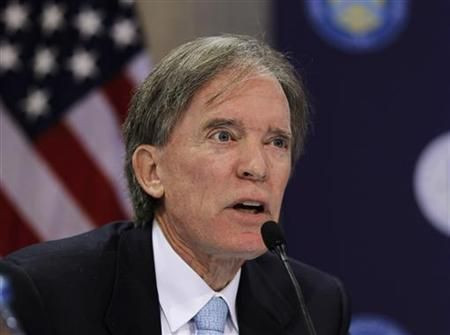PIMCO Leader Takes Federal Reserve Chairman Ben Bernanke To Task Over Low Interest Rates, Saying They Aren't Working And May Be Part Of The Problem

The head of the world's largest bond fund has unloaded on the head of the world's largest central bank, saying the Federal Reserve's unprecedented policy of monetary easing -- effectively, money printing -- is failing and, worse, setting up the economy for serious trouble.
Since last fall, the Fed has been buying $85 billion of bonds each month. The intent has been to drive down interest rates, which move in the opposite direction from bond prices, so that it becomes less expensive to borrow and, thus, stimulates business activity. The stated aim is to cut the unemployment rate from its current 7.5 percent as the economy struggles to recover from the recession of 2008-2009.
The policy has been a partial success. The Fed's key interest rates have indeed dropped and are now less than 1 percent. However, although rates are now at extremely low levels, job creation is anemic, and the gross domestic product is struggling to grow at even the modest level of 2 percent. The policy has also enriched bond investors, who have made huge paper profits investing in bonds.
Further, because the Fed has been buying vast quantities of bonds, its balance sheet is now bloated, holding trillions of dollars in bonds, many times over what it normally holds. Concerns have been rising among investors about the bond price decline that will ensue once the Fed stops printing money and begins to sell the vast quantity of bonds it is temporarily holding.
William H. Gross, managing director of PIMCO, took Bernanke to task in his monthly newsletter for both the policy's failures.
"Central banks ... seem to believe that higher and higher asset prices produced necessarily by more and more quantitative easing will inevitably stimulate real economic growth via the spillover wealth effect into consumption and real investment," Gross wrote. "That theory requires challenge if only because it doesn’t seem to be working very well. Their near-zero-based interest rates and [quantitative easing] that have lowered carry and risk premiums have stabilized real economies but not returned them to old normal growth rates."
Also, there has been ample time for the economy to get up to speed.
"Low yields, low carry, future low expected returns have increasingly negative effects on the real economy," Gross wrote. "Granted, Chairman Bernanke has frequently admitted as much but cites the hopeful conclusion that, once real growth has been restored to ‘old normal,’ then the financial markets can return to those historical levels of yields, carry, volatility and liquidity premiums that investors yearn for. Sacrifice now, he lectures investors, in order to prosper later. Well, it’s been five years, Mr. Chairman, and the real economy has not once over a 12-month period of time grown faster than 2.5 percent."
Using the rather gothic-novel analogy of a “wounded heart” for the nation's economy and blood for the money that the Fed injects into the "patient," Gross said the Fed may be as much a part of the problem as Congress.
“It’s your policies that may be now part of the problem rather than the solution. Perhaps the beating heart is pumping anemic, even destructively leukemic blood through the system. Perhaps zero-bound interest rates and quantitative easing programs are becoming as much of the problem as the solution. Perhaps when yields, carry and expected returns on financial and real assets become so low, then risk-taking investors turn inward and more conservative as opposed to outward and more risk seeking. Perhaps financial markets and real economic growth are more at risk than your calm demeanor would convey.”
© Copyright IBTimes 2024. All rights reserved.





















